
Heading
No Rhythm No Life
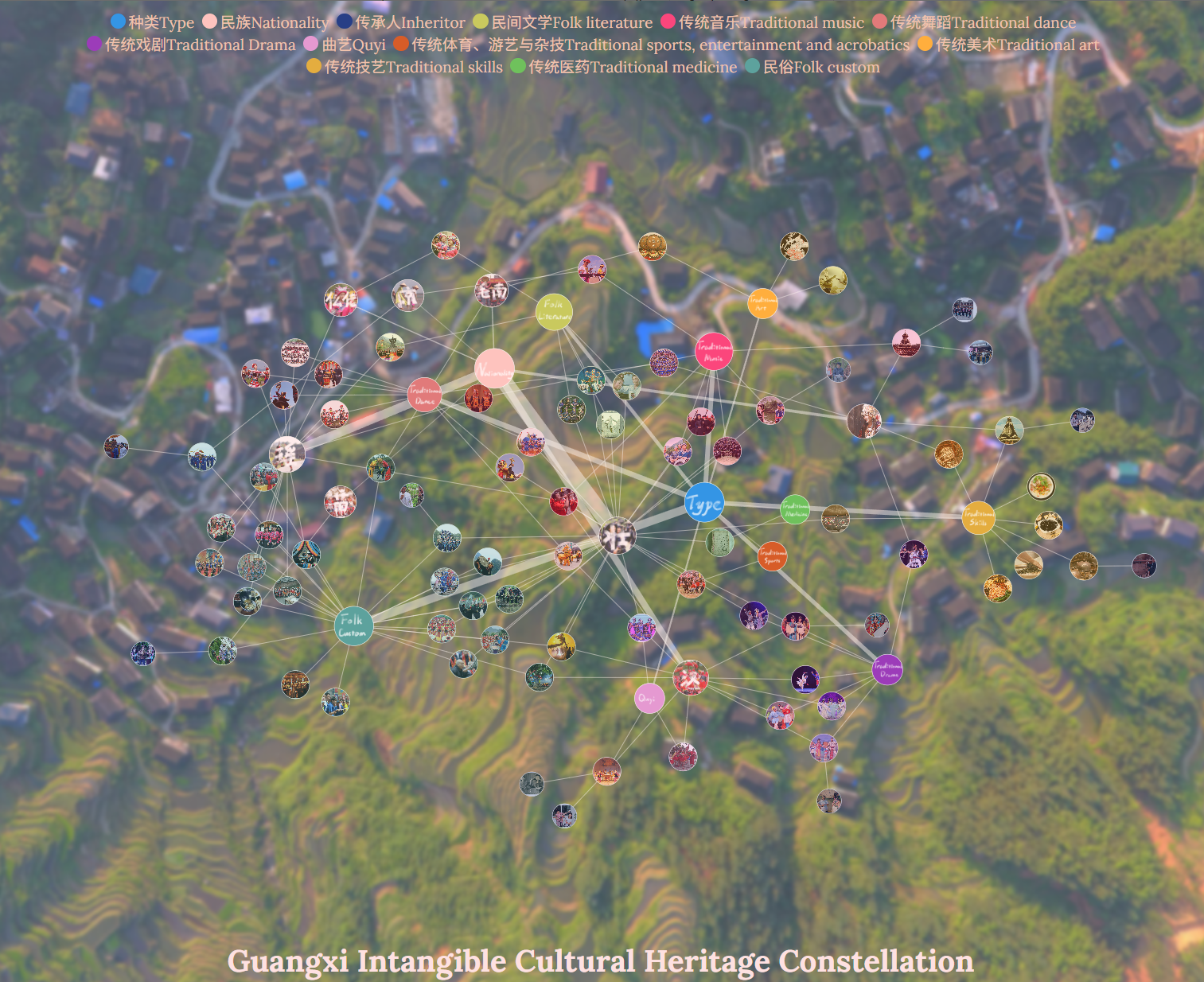
Heading
Interactive Heritage Map
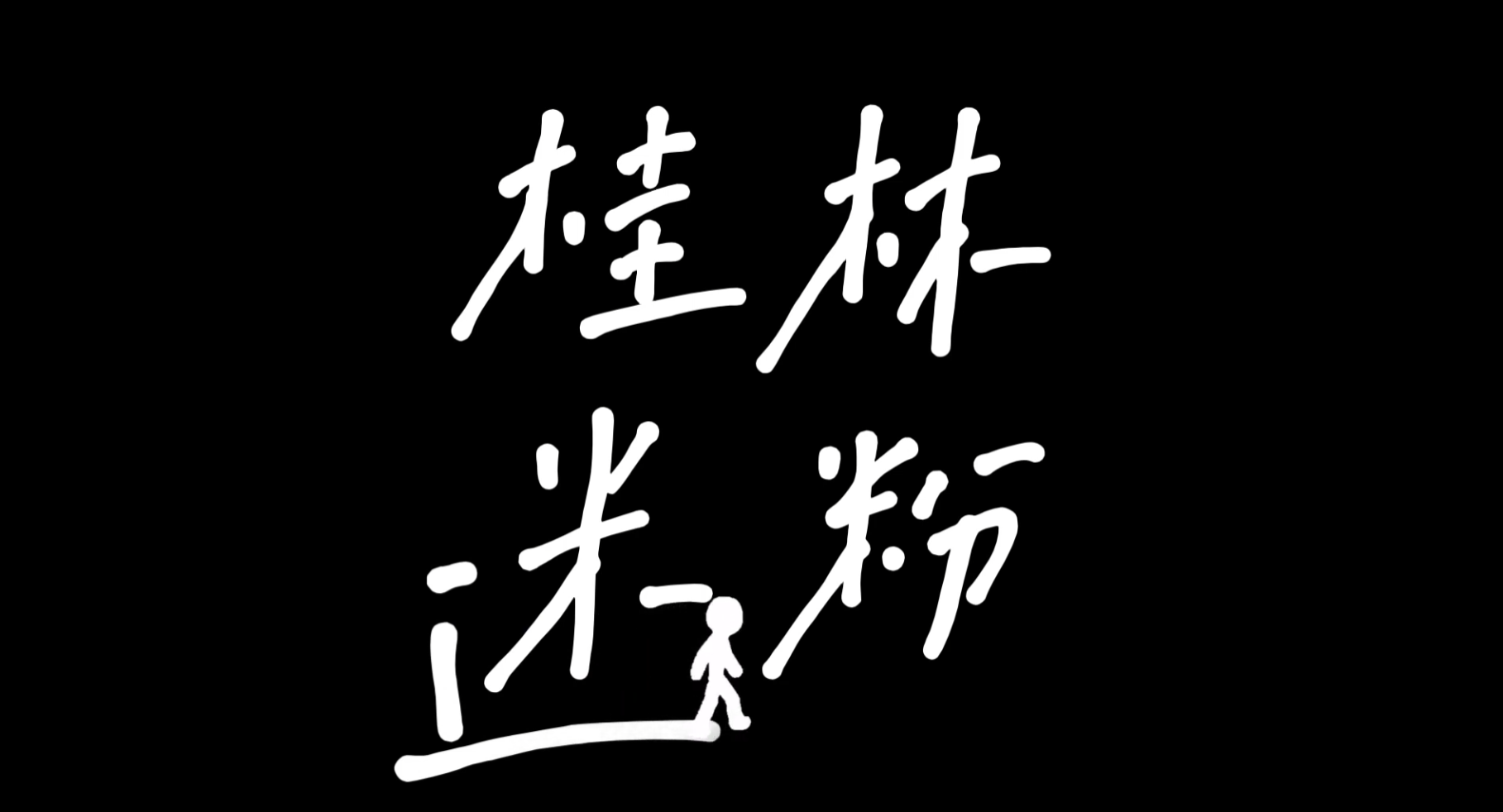
Heading
The Lost of Guilin Rice Noodle
Abstract
Digital Humanity is a lively discussed topic nowadays, and people try to explore how emerging digital technology affects research and practice in the humanities. After we (Rachel and I) separately finished our 1st-7 self-exploration, we tried to cooperate together to make a documentary about Guilin Rice Noodle, which is a type of traditional and cheap food in Guilin and is also certified as ICH. We chose documentary as our 2nd 7-week exploration because we wanted to learn more about image capture and image editing skills through this project. Since the documentary is relatively traditional compared to programming, VR, AR, etc., and has been used extensively to explore intangible cultural heritage in relation to food, we did not only want to learn a type of technology (our 1st 7- week of projects were more technical in nature), but we also wanted to understand the story behind a cultural heritage. Based on our shooting material, we also hope to offer a potential answer to why a certain ICH failed to be spread, and we hope someone who wants to spread a type of ICH could gain inspiration from our documentary.
Project Description
This is a documentary related to food and humanities about Guilin rice noodles. It is a collaboration between Rachel and Kaitlyn, but what we hope to gain from this work is not exactly the same. We both hope to explore the stories behind intangible cultural heritage, as well as learn the process of documentary production and the techniques of editing audio-visual materials; the difference is that Kaitlyn, as a local of Guilin, is more interested in exploring the combination of intangible cultural heritage and new media technology, while Rachel, as a Beijinger with less exposure to Guangxi culture, is interested in the stories behind Guilin rice noodles; therefore, we went into the documentary with different thinking directions.
Our initial idea was to find some existing arguments on the internet and Kaitlyn's views on Guilin rice noodles, and to find relevant material in Guilin's Guilin rice noodle stores and Shanghai's Guilin rice noodle stores to prove our original point. But interestingly enough, we found that during our filming, we explored far more than we had originally thought. After discussing with a professional documentary director, mentor, he said that our work should have clues and rely on clues to advance the story, rather than using our own made-up logic, so we finally decided to make a documentary about our rice noodle documentary, and we hope to use real footage and stories to show our real exploration process and insights.
Visual Documentation
Context and Perspective
Our project is a food documentary. Generally speaking, food documentaries are not only about the process and preparation of the food, but also about the human stories behind the food through filming and recording. Through the documentary off the menu: Asian America, director Grace Lee talks to food scholar Krishnendu Ray (NYU Food Studies) and from the food documentary 《寻味“左宗棠鸡”| The Search For General Tso》, we can learn that food can reflect human characteristics. For example, the spices Asian Americans use in their food and the names they give to their food are consistent with their history of migration.
Our food documentary is about Guilin rice noodles and the people who depend on them for their livelihood (local Guilin diners and owners of rice noodle stores). The documentary focuses on Rachel's interest in Kaitlyn's hometown rice noodles, her trip to Guilin to taste the rice noodles and explore the story behind the noodles, and her return to Shanghai where she continues to search for a rice noodle store because she misses the noodles. Our story moves from the taste of rice noodles at the beginning to people's reliance on rice noodles and finally to the exploration of the spread of rice noodles, the content gradually becomes more meaningful, which is the most basic requirement for a good food documentary.
Designs and Ideas
Initially, we decided to divide our documentary into 3 sections - for Guilin people Guilin Rice Noodle means to Life, Heritage and Spirit, and along these lines we designed our interview outline and finished our Guilin on-site filming. After we met with our mentor, we found that we made the mistake that we wrote the story based on our imagined logic, which means our storyline cannot be understood by our audiences because be do not have the basic clue to link the footages together. Then we rethought how to create a new logical story without giving up our existing filming materials and to finish our interview in Shanghai. Our second story is to utilize ChatGPT that we ask ChatGPT what does the Guilin Rice Noodle mean to Guilin People, and we verify the authenticity of its answer through interview. However, we still found that the storyline is embarrassing. We finally made the decision that our documentary could record our real life which is a logical story because it indeed happened - we record that Rachel felt interested in Guilin Rice Noodle and we travel to Guilin to eat it and than try to learn the stories behind it.
We hope to make a explanation for our project name here.
Guilin Rice Noodle in Chinese in 桂林米粉 and our project name is 桂林迷粉. The only one difference is the character 米 and 迷, and in Chinese their pronunciations are pretty similar. 米 in English is rice, while 迷 in English means lost. In our documentation, we found that compared to Lanzhou Beef Noodle or some other traditional Chinese snack, we found that Guilin Rice Noodle lost its market outside Guilin. Besides, compared to 米, 迷 contains a 辶 which means walking and it represents that we walk to everywhere to find Guilin Rice Noodle.
Development and Technical Implementation
The production of the documentary is divided into two parts: one is filming and the other is editing. During the filming process, we mainly relied on handheld phones to film the footage which caused problems with the low quality of the footage, so during our filming in Shanghai we downloaded professional filming app for cell phones which allowed us to fix the focus, light and make the filming more stable. We purchased microphone sound collecting equipment, but because the interview was in a rice noodle store (a noisy restaurant) and it was raining heavily at the time of the interview, the sound was still not as good as it could have been, even with the use of a microphone.
We used Premiere for the main editing, and cut-screening for the credits and subtitles. In addition, we also used the GarageBand for the soundtrack.
Our Individual work:
Rachel: Rachel was responsible for shooting all the interview footage and most of the empty shots as well as editing all the main body of the documentary. In addition, Rachel made full use of her musical talents and created several original soundtracks for the documentary.
Kaitlyn: Kaitlyn primarily played a role as the interviewer for the interviews and assisted in filming some of the empty shots. During the editing process Kaitlyn translated and added subtitles and designed the credits for the documentary.
User Testing
It is a very useful user test. First, we are confirmed that our basic idea and logic line make sense to most of our user. Second, what Linda said “not sections but lines” is very important. It reminds us that a clue and a complete storyline is necessary for a good documentary. If we use sections, then it will be a video filled with our own logic, rather than a documentary which should has its own line. Last but not least, what Shane said “add on related information” is a good add on point that we didn’t think of before, that is, if we don’t have enough time to cover all the information, we can also use some materials to help us explain, rather than leave the blank there.
Revisions
Point1.Before we started filming we watched a lot of food documentaries and learned how they were made and how they were thought about, we had a lot of discussions about it and decided on some initial ideas (although unfortunately they were changed)
Point2.We got a lot of good information and suggestions from our mentor, and we realized the need for the documentary to have a narrative clue, so we revised our initial script after the mentor meeting.
Point3.During our production process, our ideas continued to change, we kept discussing and refining them, and the final film was created after we changed our minds over and over again. Our final story became a documentary of Kaitlyn and Rachel's quest, which was actually the result of discussions in the last two weeks of production.
Presentation
First of all, we appreciate all the professors and classmates who watched our presentation, and we were very happy to hear all the compliments and discussions about our work. However, because of the limited length of our presentation and the lack of explanation of our work, we were not able to explain all the ideas clearly in class.We especially want to respond to the comment that our work is like a vlog. Our mentor said that because Rachel and Kaitlyn are not professional documentary students, if we cannot meet many of the academic requirements for making a documentary, a newer and more relaxed format would be used that we appear in the camera to guide the story. During the conversation, we also asked the same question, "Will our appearances make the documentary look like a vlog? Our mentor told us that vlogs are not an art form, but a new genre created by categorizing videos on the internet. Our project may feel similar to vlogs on the web, but it doesn't negate the fact that the project we are making is a documentary.
Conclusion
First of all this documentary is a two-person collaboration between Kaitlyn and Rachel, and the ultimate completed one shows that the collaboration between the two was a success collaboration. Our initial common goal was to explore the process of documentary filmmaking, and we did learn many, many ways and techniques of making documentaries from this project, but documentaries being a centuries-old art form, we must not have been able to learn very much from just seven weeks, and therefore what we produced did not look very professional.On the technical side, the two of us got some practice in the use of camera language and the use of software, and improved in our abilities.In terms of cultural heritage exploration, we rediscovered a more traditional form than AR and web production, and also learned about the connection between cultural heritage and humanities. habits.Overall, we really learned a lot from our work, including technical theories, software skills, and humanities, and the process of discussion and collaboration between the two of us is worth remembering.

Heading
ACG Merch Platform
.png)
Heading
In Hell Exhale
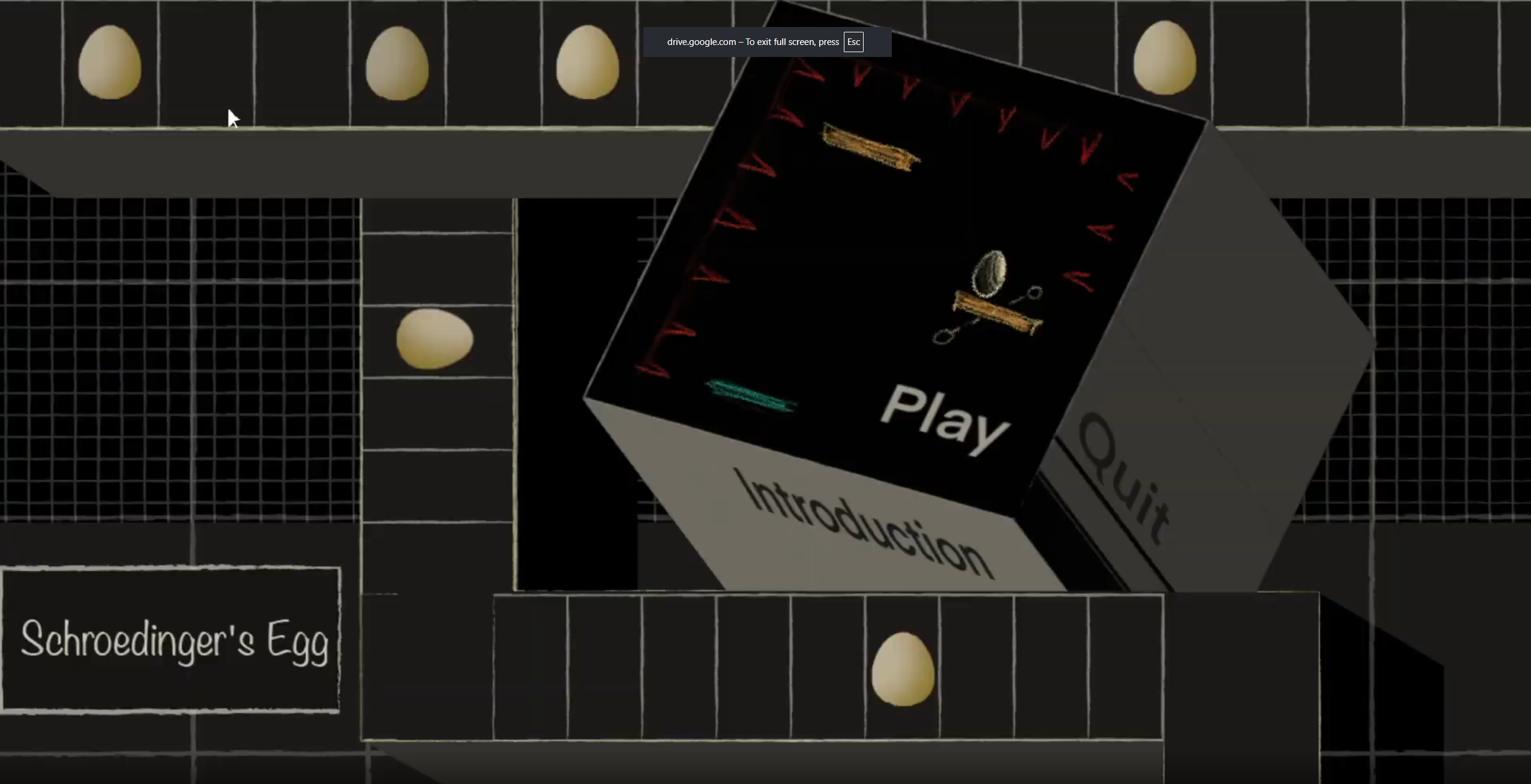
Heading
Schroedinger's Egg
Download the game and have fun! (Windows)
https://drive.google.com/file/d/1V8fwdsXzqnkECrd3AMZNR4-TLDO9auwe/view?usp=sharing

Heading
Chinese Spring Festival Museum
December 19, 2022
I. Final Presentation
II. Presentation Pictures
(Because I was presenting during the show, so I didn’t take too much pictures)

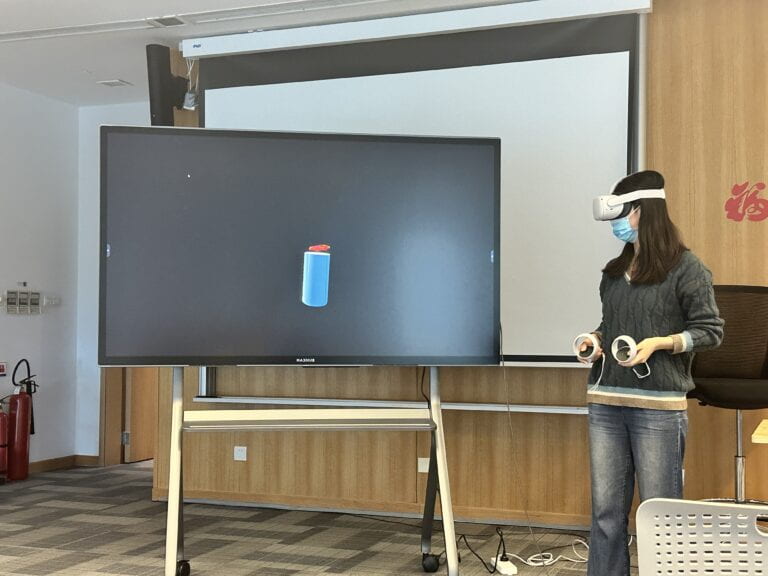

III. Technical Process and Conceptual Approach
During the working process, our group changed the idea a lot. After we decide on the “Spring Festival” topic, we first plan to create an interactive movie to compare the original and nowadays festival. However, after one day’s working and we found that it is too hard for us to learn how to control a character in unity, which should be a big part of the movie. In this case, we quickly changed our idea to create an online museum.
The museum is designed to be separated into four rooms, and each of us shoulders one room’s decoration. My room is the Firework room and I also shouldered the responsibility to create the opening and the initial museum room.
a. The Fireworks Room
The basic idea of these fireworks is to let the player create fireworks on their own, to create some festival atmosphere in the silent city.
At first, I researched the particle system, trying to create the firework effect on my own. However, Kaitlyn helped me to find a brilliant firework model on Taobao, and I used them at last. The model we bought has a total of twenty fireworks prefabs, and I chose eight of them to let the users click on and play. For this part, I used the UI system, that is creating the canvas and bottom, and replaced the bottom with the fireworks pictures. The pictures are the screenshot of the prefabs preview, and to make it fitter with the VR environment, I also used photoshop to make the pictures more stereoscopic. At last, to make it more convenient for the users to operate, I linked the canvas with the VR camera, so that it can move with the user’s sight.
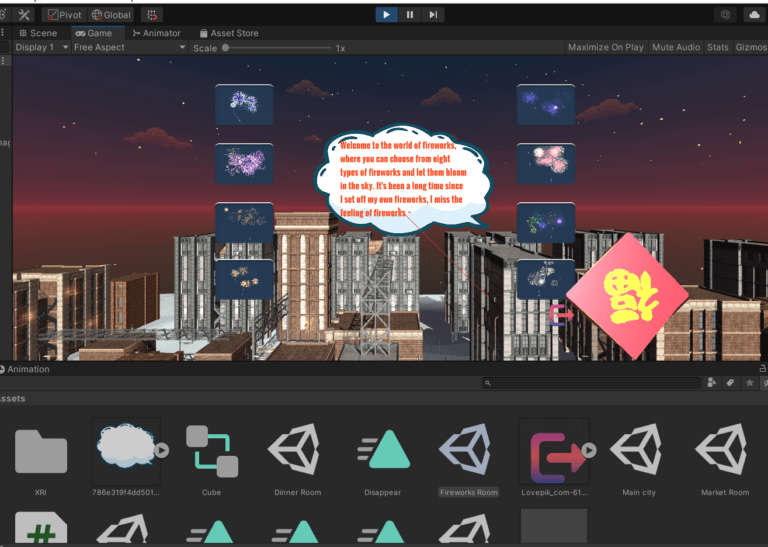
Although it is a small detail, to make the city more feel like a festival environment, I changed all the light colors in this model into a warmer colors. Before there were lots of blue and white lights, and I changed them all into red and yellow. If there were more times, I would like to make more festival decorations on it.
As for the UI system, it is here that I learned how to create canvases and buttons and make it can interact in the VR world. It also creates the foundation for me to make other interactions between different rooms. Here is the video that I learn on: UI Using Unity XR Interaction Toolkit | How to Make a User Interface That Works in VR
b. The Opening
Although the opening scene is very short, it is still a very important part of our project, for it introduced the basic background of our project. I create a modern city first to represent nowaday’s city, and when the camera is moving, there is also audio saying that “This year’s Spring Festival is still boring”, and “I wish I can hear fireworks and eat dumplings with families together” and so on, showing the background that there is not a lot of festival atmosphere nowadays. When the camera zoom in, we can see a red room with the title “Spring Festival Museum”, letting the players know that we create this museum to show we yearn for the previous festival atmosphere.
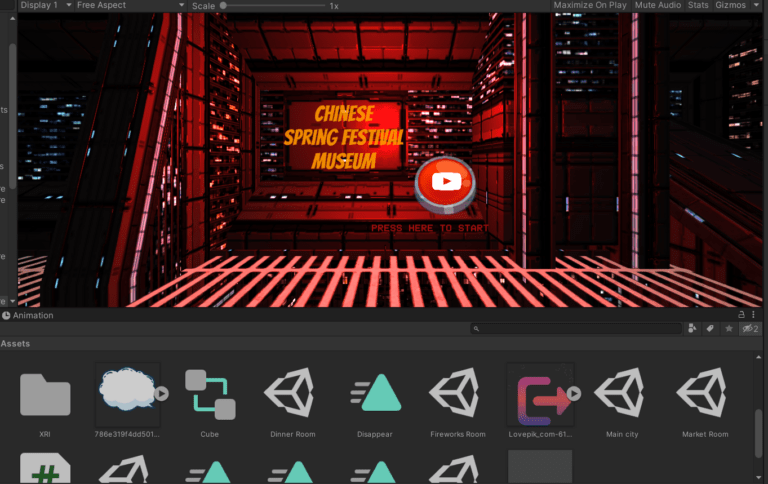
Still a small detail, but I also create long posters and add them to the original city model, so that we can have a feeling: this city is also celebrating the festival, but doesn’t have any festival atmosphere. Also, I didn’t change the light color in this model, also trying to show the comparison that there is no festival atmosphere except the posters.

Also, the animation of the camera that makes it fly above the city to the museum feels really different in the VR world, it gives us an immersive feeling of flying above the city, which is pretty cool and fun.
c. The Museum Room
This is a really simple setup with four posters representing our exhibition room. For this room, I create a simple room set up with materials and lights, making it just the same as an ordinary museum room in the real world. However, this is also a special point we want to show in this project, which is the unique point of the VR museum. In the real world, the museum is made up of various rooms with different showpieces. However, in the VR museum, the museum room is only one small room, but you can explore different things by clicking on it. And without letting the audience go into another room, the space is totally different after the audience chooses the showpiece, which is another interesting point we think of in our project.
To keep our rooms in one style, we also choose similar-style posters, and if there are more times, we would like to add beautiful and same-style names to our rooms.
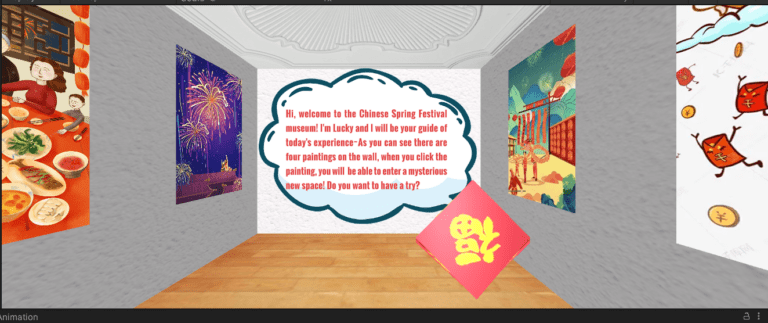
Also, here is the scene where I learn how to change the scene with the buttons, which is also helpful for me to add the “exit” button in the exhibition rooms. Here’s the link that I reference:
https://blog.csdn.net/dislike_carry/article/details/126800139, https://blog.csdn.net/alayeshi/article/details/40344907
d. Link Four Rooms
As the one who has the best computer in this group, I also shouldered the responsibility to link each other’s rooms into a complete project. Not to say the debug project, I also pay a lot of attention to making the scenes into one similar style. The first is to unify the subtitles that everyone made. I changed the UI text into the UI textmeshpro, so that the words can be seen clearly, and I also unified the front that we use. Also, since the subtitle we create is actually the words that our Fu director speaking of, I choose the dialog box picture to be the background of the words, trying to spread the meaning of there is a director leading the audience to look around.
Also, although not knowing why there are bugs with everyone’s VR settings, I copy and paste my VR camera into everyone’s scene to solve the problem, also linked the Fu director with every scene’s camera, and add the exit bottom to every room. It’s not a complex process, but do cost me time to build the scene four times to check if there is anything else that hasn’t been unified.
IV. About our team
First, I would like to thank everyone in our group, that everyone is supportive from the beginning to the end. Although we changed ideas a lot, no one complain about the wasted work, and always started to work on the next idea energetically. Without encouragement from the group member, I cannot complete such a big and hard project.
Kaitlyn is the person who shared the second most workload. She created the Fu director with the soft effect, and also create all of the audio effects for the Fu director. She worked on the room which is called The Dinner Room, with lots of dishes that can create dialogue that the audience clicks on it. During the working process, we two spend time in 503 and spend nights in the academic building for two nights.
Claire and Charlotte both work on their own rooms separately and hand in the rooms on time, so that I can have time to link them together. Claire works on the room called The Decoration Room, and Charlotte works on the room called The Red Package Room. These two are also filled with the festival atmosphere and fulfilled our project successfully.
The night before the presentation, we four all leave in the 503 to complete the very last work and slept in the academic building together. When morning come and we realize that the class is going to begin, we joked that it is our home and that is going to treat guests, for the scene is really like we made a field trip in 503, with food and changing clothes. No matter how difficult the process is, we complete the hard tasks successfully. Although there is still a lot of space for us to improve, I’m still very proud of what we made as our first unity project. Thank you all and special thanks to Prof. Yunmi! Hope next time I can do better and create a better project.
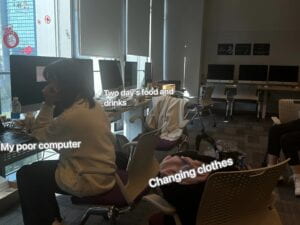


Heading
Intlab Blind Stick
October 24, 2021
Introduction Videos:
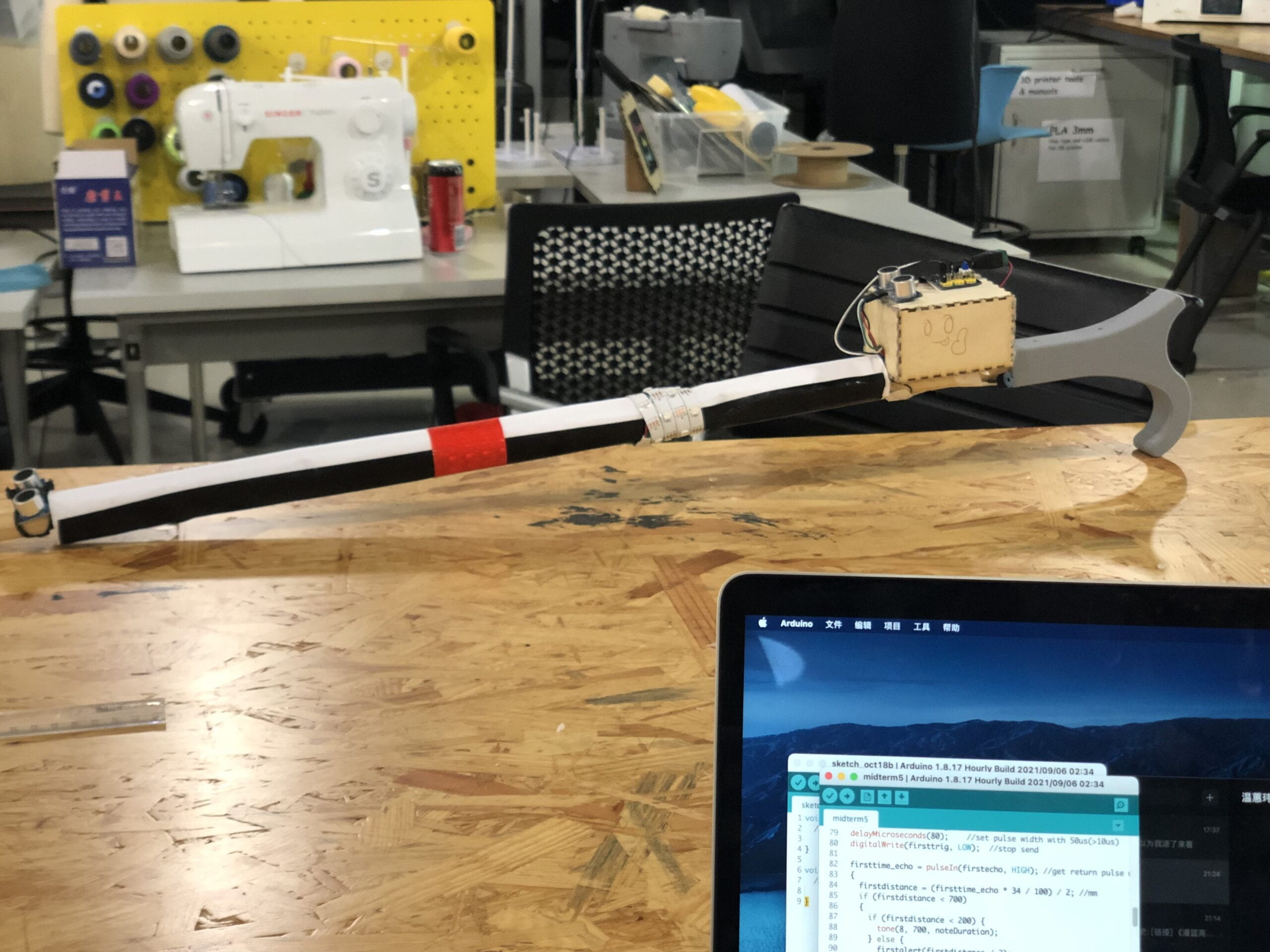
I. CONTEXT AND SIGNIFICANCE
As this is our first individual project, in the beginning, we decided to use the sensors we had already studied to complete our project. During the research, we asked a sophomore what she had designed for the midterm project, and her answer was a machine to read the color for blind people. It was the time when we came up with an idea–using the ultrasonic rangers and buzzers to make a prompting-distance blind stick for blind people.
We thought it was different from the normal one because when there are some obstructions get closer, the blind stick will make a sound to remind people. The usual blind sticks are used in the way of holding it to touch if there is something ahead, and what we did was using the machines to measure the distances. We hope this stick can help blind people to learn about the road conditions more ahead of time and thus avoid being tripped over. We thought our project may be more useful than the normal one for blind people.
After the first user-testing part, we also added some elements to make the blind stick more practical. It was equipped with a photosensitive lamp, which will automatically turn on when the day gets darker, and some light reflection strip that will light up when a beam of light turns to it. Both are used to remind normal people, that someone is walking ahead so that the people can consciously make way for them.
Because it is a more useful staff rather than a thing for fun, we thought using this blind stick is an interaction thing. The buzzer will make sounds when people are holding the stick, getting closer to something, and the sound can warn people to change the way they go forward and avoid people being tripped over. This is the process of “input (the distance), read, and output (by sound)”.
II.CONCEPTION AND DESIGN
The stick consists of four parts: the detachable handle, a switch with charger battery, the distance measuring devices with the sound-warning buzzer, and the stick with brightening parts. The other three parts are all be installed on the stick part, which is the body of our project.
At first, we tried to make the telescopic pole to adjust the length of the stick so that it could fit with people of different heights. However, the 3D printer could not be made a telescopic pole that could slide, so we changed the idea into making the handle in different lengths. These detachable handles can be easily assembled to the stick so that people with different heights can adjust the stick into the one which is suitable for them. The handle is designed in some waves, which is more convenient for people to hold and use it. The battery and switch are installed just below the handle so that people can easily switch on and off this equipment due to their needs.
The measuring devices include two ultrasonic rangers, one on the mid-upper and one on the bottom, which is designed to measure the obstructions in a larger range. The ultrasonic rangers are linked with the buzzer so that when the distance they measured is close and get in a safety-distance range, the buzzer will make a sound to warn. To make it more convenient to use, we designed different tunes to distinguish the distances-warning caused by different height’s ultrasonic rangers, so that it can tell people how high the obstacles are or where they come from. We also designed that the warning buzzer’s sound will be more and more urgent when the obstructions are measured getting closer and closer, which can help the blind people estimate the distance between the obstacles and themselves. Because of the element’s low equality, the buzzer’s sound is some-kind small, so it is installed on the top of the stick in purpose to get closer to people’s ears and be easier to hear.
The photosensitive lamp and light reflection strips are equipped on the middle, which is the most visible part of the stick and can fully meet our needs of reminding others. This part is also very useful during the decoration part. Not only have they lightened the whole stick, but also made the stick more colorful and funnier, as we designed the photosensitive lamp to shine in a color of flowing rainbow.
At last, to make the stick more artistic, we make a box through laser cutting to install the main circuit board and power lines and then use decorations to cover the lines which are still visible. In this way, the whole stick looked neater and more sensuous.
III. FABRICATION AND PRODUCTION
The circuit:

The design drawing:


The poster:

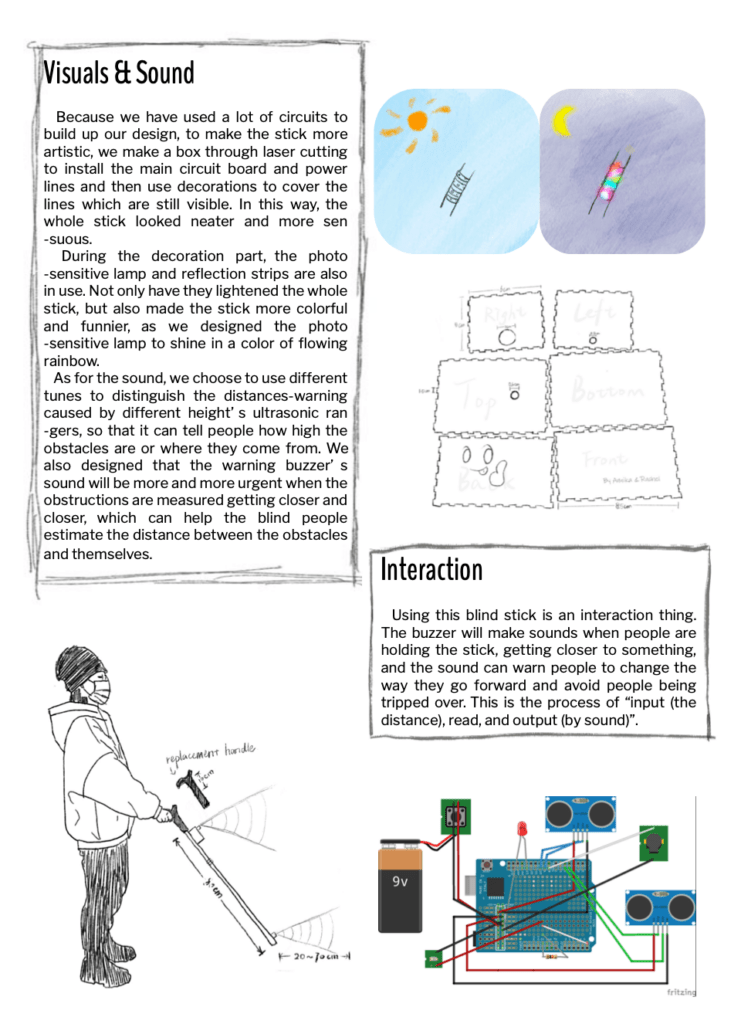
The code:
#include <FastLED.h>
int beeppin = 8;
int noteDuration = 100;
//for the LED
int LED = 13;
int val = 0;
#define AD5 A5
//for the forward
int firstecho = 10;
int firsttrig = 9;
unsigned long firsttime_echo = 0; // record the pulse width by sensor returns
unsigned long firstdistance = 0; // record the distance value;
//for the ground
const int secondtrig = 4;
const int secondecho = 5;
unsigned long secondtime_echo = 0;
unsigned long seconddistance = 0;
//For the LED
#define LED_PIN 13
#define LED_TYPE WS2811
#define COLOR_ORDER GRB
#define NUM_LEDS 15
CRGB leds[NUM_LEDS];
#define BRIGHTNESS 64
#define UPDATES_PER_SECOND 100
CRGBPalette16 currentPalette;
TBlendType currentBlending;
extern CRGBPalette16 myRedWhiteBluePalette;
extern const TProgmemPalette16 myRedWhiteBluePalette_p PROGMEM;
void setup() {
Serial.begin(9600);
pinMode(beeppin, OUTPUT);
pinMode(LED, OUTPUT);
delay( 3000 ); // power-up safety delay
FastLED.addLeds<LED_TYPE, LED_PIN, COLOR_ORDER>(leds, NUM_LEDS).setCorrection( TypicalLEDStrip );
FastLED.setBrightness( BRIGHTNESS );
currentPalette = RainbowColors_p;
currentBlending = LINEARBLEND;
//for the forward
pinMode(firstecho, INPUT);
pinMode(firsttrig, OUTPUT);
//for the ground
pinMode(secondtrig, OUTPUT); // Sets the trigPin as an Output
pinMode(secondecho, INPUT); // Sets the echoPin as an Input
}
void firstalert(unsigned i) {
tone(8, 700, noteDuration);
delay(i);
noTone(8);
delay(i);
}
void secondalert(unsigned i) {
tone(8, 600, noteDuration);
delay(i);
noTone(8);
delay(i);
}
void loop() {
//for the forward
digitalWrite(firsttrig, HIGH); //send pulse
delayMicroseconds(80); //set pulse width with 50us(>10us)
digitalWrite(firsttrig, LOW); //stop send
firsttime_echo = pulseIn(firstecho, HIGH); //get return pulse width
{
firstdistance = (firsttime_echo * 34 / 100) / 2; //mm
if (firstdistance < 700)
{
if (firstdistance < 200) {
tone(8, 700, noteDuration);
} else {
firstalert(firstdistance / 2);
}
}
Serial.print("forwardDistance: ");
Serial.println(firstdistance);
delay(10);
};
//for the ground
digitalWrite(secondtrig, HIGH); //send pulse
delayMicroseconds(80); //set pulse width with 50us(>10us)
digitalWrite(secondtrig, LOW); //stop send
secondtime_echo = pulseIn(secondecho, HIGH); //get return pulse width
{
seconddistance = (secondtime_echo * 34 / 100) / 2; //mm
if (seconddistance < 700)
{
if (seconddistance < 200) {
tone(8, 600, noteDuration);
} else {
secondalert(seconddistance / 2);
}
}
Serial.print("groundDistance: ");
Serial.println(seconddistance);
delay (10);
};
//for the LED
val = analogRead(AD5); // 读取电压值0~1023
Serial.print("the light is:");
Serial.println(val); // 串口查看电压值的变化
Serial.println('\n');
delay(10);
if (val < 800) { // 一旦小于设定的值,LED灯关闭
fadeToBlackBy( leds, NUM_LEDS, NUM_LEDS);
FastLED.show();
delay(0);
} else { // 否则LED亮起
ChangePalettePeriodically();
static uint8_t startIndex = 0;
startIndex = startIndex + 1; /* motion speed */
FillLEDsFromPaletteColors( startIndex);
FastLED.show();
FastLED.delay(1000 / UPDATES_PER_SECOND);
}
}
void FillLEDsFromPaletteColors( uint8_t colorIndex)
{
uint8_t brightness = 255;
for ( int i = 0; i < NUM_LEDS; ++i) {
leds[i] = ColorFromPalette( currentPalette, colorIndex, brightness, currentBlending);
colorIndex += 3;
}
}
void ChangePalettePeriodically()
{
uint8_t secondHand = (millis() / 1000) % 60;
static uint8_t lastSecond = 99;
if ( lastSecond != secondHand) {
lastSecond = secondHand;
if ( secondHand == 0) {
currentPalette = RainbowColors_p;
currentBlending = LINEARBLEND;
}
if ( secondHand == 10) {
currentPalette = RainbowStripeColors_p;
currentBlending = NOBLEND;
}
if ( secondHand == 15) {
currentPalette = RainbowStripeColors_p;
currentBlending = LINEARBLEND;
}
if ( secondHand == 20) {
SetupPurpleAndGreenPalette();
currentBlending = LINEARBLEND;
}
if ( secondHand == 25) {
SetupTotallyRandomPalette();
currentBlending = LINEARBLEND;
}
if ( secondHand == 30) {
SetupBlackAndWhiteStripedPalette();
currentBlending = NOBLEND;
}
if ( secondHand == 35) {
SetupBlackAndWhiteStripedPalette();
currentBlending = LINEARBLEND;
}
if ( secondHand == 40) {
currentPalette = CloudColors_p;
currentBlending = LINEARBLEND;
}
if ( secondHand == 45) {
currentPalette = PartyColors_p;
currentBlending = LINEARBLEND;
}
if ( secondHand == 50) {
currentPalette = myRedWhiteBluePalette_p;
currentBlending = NOBLEND;
}
if ( secondHand == 55) {
currentPalette = myRedWhiteBluePalette_p;
currentBlending = LINEARBLEND;
}
}
}
// This function fills the palette with totally random colors.
void SetupTotallyRandomPalette()
{
for ( int i = 0; i < 16; ++i) {
currentPalette[i] = CHSV( random8(), 255, random8());
}
}
void SetupBlackAndWhiteStripedPalette()
{
// 'black out' all 16 palette entries...
fill_solid( currentPalette, 16, CRGB::Black);
// and set every fourth one to white.
currentPalette[0] = CRGB::White;
currentPalette[4] = CRGB::White;
currentPalette[8] = CRGB::White;
currentPalette[12] = CRGB::White;
}
// This function sets up a palette of purple and green stripes.
void SetupPurpleAndGreenPalette()
{
CRGB purple = CHSV( HUE_PURPLE, 255, 255);
CRGB green = CHSV( HUE_GREEN, 255, 255);
CRGB black = CRGB::Black;
currentPalette = CRGBPalette16(
green, green, black, black,
purple, purple, black, black,
green, green, black, black,
purple, purple, black, black );
}
const TProgmemPalette16 myRedWhiteBluePalette_p PROGMEM =
{
CRGB::Red,
CRGB::Gray, // 'white' is too bright compared to red and blue
CRGB::Blue,
CRGB::Black,
CRGB::Red,
CRGB::Gray,
CRGB::Blue,
CRGB::Black,
CRGB::Red,
CRGB::Red,
CRGB::Gray,
CRGB::Gray,
CRGB::Blue,
CRGB::Blue,
CRGB::Black,
CRGB::Black
};
In the very beginning, we searched for some strategies online to build the basic circuit. However, during the process, we changed the circuit and code due to our new needs, and we slowly got rid of the model of online strategy and successfully built our own project.
My teammate Annika first built the basic circuit part according to the online model, and she fixed the elements to the stick. After trying out the first version, we decided to add the battery and the switch so that it was more seemed like a tool, but not a project made by students, which is the second version. Then we came up with some ideas for preventing the security problems, which made us decide to build the part of the photosensitive lamp. This is almost the last version of the blind stick and is also a unique improvement for our project. At last, to make the stick seem more complete, we added the laser-cut box and some paper to cover the electric wines.
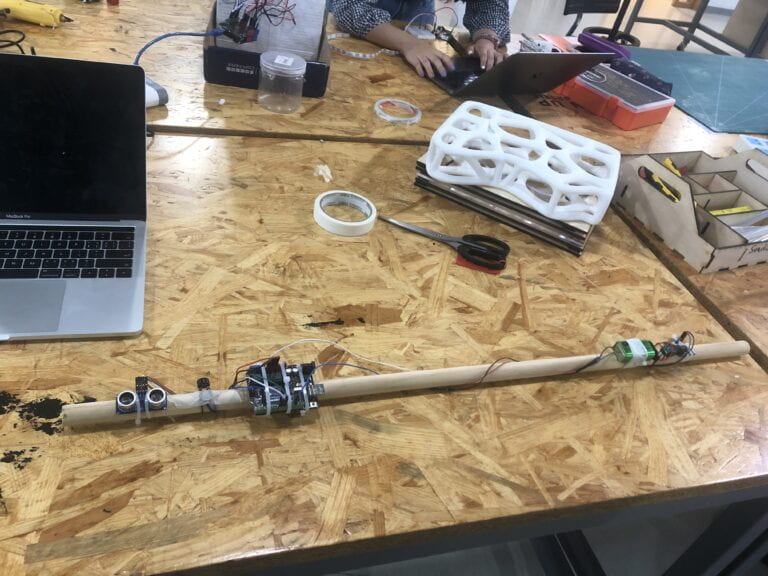
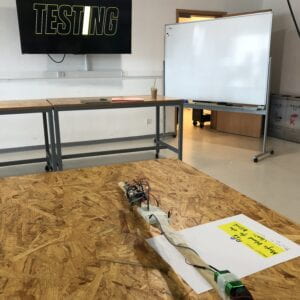
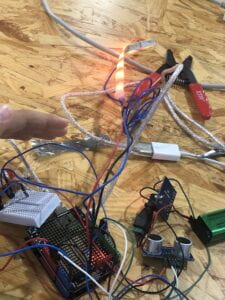
During this time, according to Rudi’s advice, I made the main circuit and tried to cut down the amounts of electric wines. Besides, I also finished the coding part, such as making the buzzer sound more urgent when the obstacles got closer, and improve the coding part of the photosensitive lamp, and changing the small LED’s code into a colorful LED strings’ one. Thanks to the online resources and the professor’s help, we successfully made our code, which I thought was the hardest part of our project.
We also met a lot of difficulties. For example, at first, we had no idea about 3D printing and laser cutting, and it felt hard to ask for help at first. Thanks to Annika’s bravery, I had beaten my fear and asked for help, which helped us to complete the project. The most impressive difficulties appeared near the end of our project making. Before we fixed the top of the box, we suddenly found that the light sensor got some problems. It was hard to operate in a narrow box, but we managed to change that sensor. However, after we fixed the top of the box, which made the circuit in a sealed place, we found there are something wrong with the LED string. At that time, there were only 14 hours before the final presentation, and we still could not fix the problems. At last, it was Professor Andy who saved us, who told us how to check the wrong place of the circuit, and told us: “Never obstruct the road before you ensure everything is ok.” This is an important lesson for us.
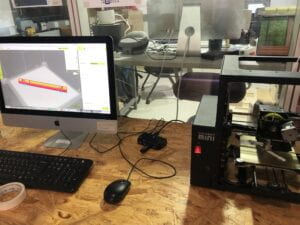
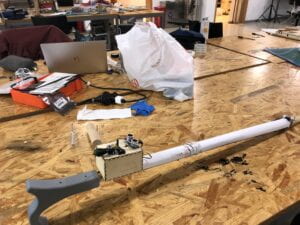
IV. CONCLUSIONS
This was an impressive experience for me, for it was the first time I totally made a thing by myself. This feeling is amazing and I really love the sense of achievement.
Besides the pleasure, according to others’ feedback, I also found that we still got a lot to improve. First is the model of the handle wasn’t good enough for people to hold, and also the rangers sounding range were too small so it couldn’t catch all of the obstacles. What’s more, the buzzer’s sound was low and was hard to hear when the background was noisy, which was also a big problem to fix. However, I thought these could all be handled as long as we got higher-quality elements.
As for the interaction part, at first, I thought what we made was a perfect interactive thing. However, after admiring other projects, I found that our interaction part was too simple. For the improvement, I thought we could record different sentences in the reaction of a different situation, such as “Turn left” or “Stop and don’t move!”, or even funnier: when nothing is ahead but the person who handle it stopped, the stick could say “why don’t keep walking? I am here to protect you!” In this case, the interaction may be more complex, just like an AI.
All in all, there is still one thing we should celebrate, that everyone can quickly understand what thing we had made! Hooray!
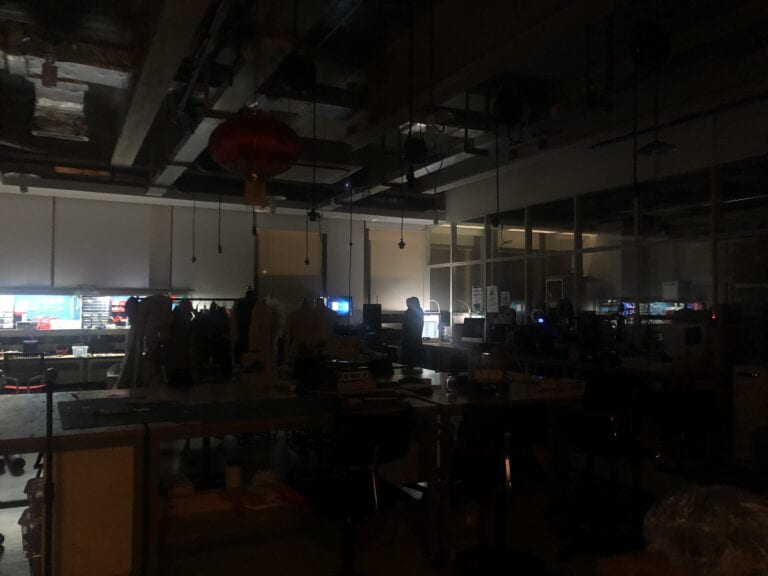
Reminding all the process we had to make through, I felt like it was just a dream.
During two weeks, we came through the process of coming up with the idea, built the basic model, asked for help and improved it, and finally got our project which was just fit with our design. We stay up late at school, making through a series of problems, and then met new problems. It was hard to keep going, but luckily we had made it.
There are two important lessons I have learned about. First, is never be afraid to ask for help, no matter from reality or from the internet. Not knowing something isn’t an ashamed thing, and asking for help is the best way to solve it. Second, is I fully understand the sentence: If you can dream it, you can do it. At first, I always felt the project was complicated, but after the step-by-step improvement, we made the project which was ten more times complicated than the first version. I learn that just keep dreaming and you can all achieve it due to the hard work at last.
Thanks to my teammate Annika, we had a great time together. And thanks to my professor Rudi and extra helper professor Andy. Thanks to Steve, who is a nice teacher and friend. Thanks to myself at last, for I overcame all the difficulties and made the success.
This is just the beginning, and more challenges and achievements are waiting for me! I believe I can make it!

